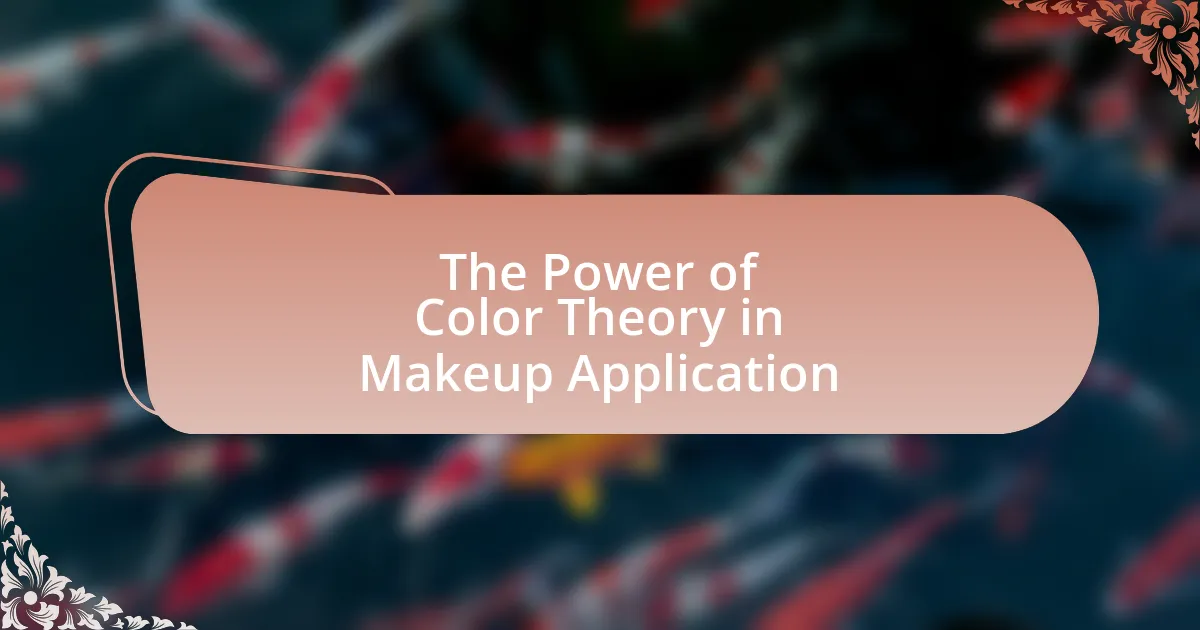The article explores the significance of color theory in makeup application, emphasizing its role in enhancing features, creating harmony, and influencing perceptions through color choices. It outlines how makeup artists utilize the color wheel to select shades that complement skin tones and eye colors, employing principles such as complementary and analogous colors to achieve desired effects. Additionally, the article discusses the psychological impact of color, detailing how specific hues can evoke emotions and influence self-perception, while providing practical techniques for applying color theory effectively in makeup artistry.

What is the Power of Color Theory in Makeup Application?
The power of color theory in makeup application lies in its ability to enhance features, create harmony, and influence perceptions through color choices. Color theory provides a framework for understanding how colors interact, allowing makeup artists to select shades that complement skin tones, eye colors, and overall aesthetics. For instance, using complementary colors can make features pop, while analogous colors can create a more subtle, blended look. Research indicates that color can evoke emotions and perceptions; for example, warm colors like reds and oranges can convey energy and warmth, while cool colors like blues and greens can evoke calmness. This understanding enables makeup artists to not only beautify but also to communicate specific moods or themes through their work.
How does color theory influence makeup choices?
Color theory significantly influences makeup choices by guiding the selection of shades that complement skin tones and enhance features. Makeup artists utilize the color wheel to identify harmonious color combinations, such as complementary colors that create contrast and enhance vibrancy. For instance, warm undertones in skin are often paired with warm shades like peach and coral, while cool undertones are matched with colors like pink and blue. This application of color theory not only improves aesthetic appeal but also ensures that makeup appears natural and flattering. Studies in color psychology indicate that specific colors can evoke emotions and perceptions, further influencing makeup choices to align with desired moods or occasions.
What are the basic principles of color theory relevant to makeup?
The basic principles of color theory relevant to makeup include the color wheel, complementary colors, analogous colors, and the concept of undertones. The color wheel serves as a visual guide that organizes colors into primary, secondary, and tertiary categories, helping makeup artists select harmonious shades. Complementary colors, which are opposite each other on the color wheel, create contrast and can enhance features when used together, such as using orange lipstick to make blue eyes pop. Analogous colors, located next to each other on the wheel, provide a more subtle and blended look, ideal for creating natural makeup looks. Additionally, understanding undertones—warm, cool, and neutral—ensures that the chosen makeup products enhance an individual’s natural complexion, as warm undertones pair well with golds and peaches, while cool undertones suit silvers and pinks. These principles guide effective makeup application, ensuring that colors work together to enhance beauty.
How do complementary colors enhance makeup looks?
Complementary colors enhance makeup looks by creating contrast that makes features pop and adds depth to the overall appearance. When applied strategically, such as using a warm eyeshadow with cool eyeliner, the interplay between these colors draws attention to the eyes and enhances their vibrancy. This technique is supported by color theory, which states that complementary colors, located opposite each other on the color wheel, intensify each other when paired. For example, using orange lipstick can make blue eyes appear brighter, as the orange and blue contrast effectively highlights the eye color.
Why is understanding color theory essential for makeup artists?
Understanding color theory is essential for makeup artists because it enables them to create harmonious and flattering looks that enhance a client’s natural features. By grasping the relationships between colors, makeup artists can effectively choose shades that complement skin tones, correct imperfections, and achieve desired effects. For instance, knowledge of complementary colors allows artists to neutralize redness with green concealers or brighten dull complexions with warm tones. This foundational understanding is supported by the fact that color theory has been a critical component in art and design for centuries, influencing aesthetic choices and visual appeal.
How does color theory affect skin tone matching?
Color theory significantly influences skin tone matching by providing a framework for understanding how different hues interact with various skin undertones. Skin tones can be categorized into warm, cool, and neutral undertones, and color theory helps identify which shades complement these undertones effectively. For instance, warm undertones typically pair well with earthy colors like peach and gold, while cool undertones are enhanced by shades like pink and blue. This understanding is supported by the color wheel, which illustrates complementary colors that can either enhance or detract from one’s natural complexion. By applying color theory principles, makeup artists can achieve a more harmonious and natural look, ensuring that the chosen products blend seamlessly with the individual’s skin tone.
What role does color theory play in creating makeup harmony?
Color theory plays a crucial role in creating makeup harmony by guiding the selection and combination of colors that complement each other on the face. This theory is based on the color wheel, which categorizes colors into primary, secondary, and tertiary groups, allowing makeup artists to create balanced looks that enhance natural features. For instance, using complementary colors, such as orange and blue, can create striking contrasts that highlight specific areas, while analogous colors, like red, orange, and yellow, can produce a more harmonious and cohesive appearance. Research in color psychology indicates that color combinations can influence perceptions of beauty and attractiveness, reinforcing the importance of color theory in makeup application.
What are the psychological effects of color in makeup application?
The psychological effects of color in makeup application significantly influence emotions, perceptions, and social interactions. Different colors evoke specific feelings; for instance, red is often associated with passion and confidence, while blue can convey calmness and trustworthiness. Research indicates that colors can affect mood and behavior; a study published in the Journal of Experimental Psychology found that warm colors like red and orange can increase energy levels, while cool colors like green and blue can promote relaxation. Additionally, the choice of makeup color can impact self-esteem and how individuals are perceived by others, with studies showing that people often judge attractiveness and professionalism based on makeup color choices.
How do different colors evoke emotions in makeup wearers?
Different colors in makeup evoke specific emotions in wearers, influencing their mood and self-perception. For instance, red is often associated with passion and confidence, making wearers feel bold and empowered. In contrast, softer shades like pink can evoke feelings of warmth and femininity, promoting a sense of calm and approachability. Blue tones may instill a sense of tranquility and trust, while darker colors like black can convey sophistication or mystery. Research indicates that color psychology plays a significant role in emotional responses, with studies showing that colors can affect mood and behavior, thereby validating the emotional impact of makeup colors on wearers.
What colors are associated with specific moods or occasions?
Colors are associated with specific moods and occasions as follows: Red evokes passion and energy, often used in romantic settings; blue conveys calmness and tranquility, suitable for serene environments; yellow represents happiness and optimism, commonly used in cheerful occasions; green symbolizes nature and balance, ideal for refreshing themes; purple signifies luxury and creativity, often seen in artistic contexts; and black denotes elegance and sophistication, frequently used in formal events. These associations are supported by psychological studies, such as those conducted by the Institute for Color Research, which demonstrate that colors can significantly influence emotions and perceptions.
How can makeup artists apply color theory in practice?
Makeup artists can apply color theory in practice by understanding the relationships between colors to enhance skin tones and create desired effects. For instance, they utilize complementary colors to neutralize imperfections; for example, green concealers counteract red blemishes. Additionally, makeup artists can create harmonious looks by using analogous colors, which are next to each other on the color wheel, to achieve a cohesive appearance. The effectiveness of these techniques is supported by the principles of color theory, which demonstrate that color combinations can influence perception and mood, thereby enhancing the overall makeup application.
What techniques can enhance the application of color theory?
Techniques that can enhance the application of color theory include the use of complementary colors, analogous color schemes, and the understanding of color temperature. Complementary colors, which are opposite each other on the color wheel, create contrast and can make features pop, as seen in makeup looks that utilize orange and blue tones for vibrant effects. Analogous color schemes, which consist of colors next to each other on the wheel, provide harmony and can create a seamless blend in makeup applications, enhancing the overall aesthetic. Additionally, understanding color temperature—warm versus cool tones—allows makeup artists to select shades that flatter skin tones, as warm tones can brighten and cool tones can provide a more subdued look. These techniques are supported by color theory principles that emphasize the psychological and visual impact of color combinations in art and design.
How can color theory be used to correct makeup mistakes?
Color theory can be used to correct makeup mistakes by applying complementary colors to neutralize unwanted tones. For instance, if a makeup application appears too yellow, using a purple concealer can counteract the yellow hue, as purple is opposite yellow on the color wheel. This principle is supported by the fact that complementary colors effectively balance each other, leading to a more harmonious appearance. Additionally, understanding undertones—warm, cool, or neutral—allows for better selection of foundation and concealers, ensuring that the makeup blends seamlessly with the skin.
What are some common color combinations for various looks?
Common color combinations for various looks include complementary, analogous, and monochromatic schemes. Complementary combinations, such as blue and orange or red and green, create high contrast and vibrant looks. Analogous combinations, like blue, teal, and green, provide a harmonious and cohesive appearance. Monochromatic schemes, which utilize different shades of a single color, such as various tones of pink, offer a subtle and elegant effect. These combinations are widely used in makeup application to enhance features and create desired moods, supported by color theory principles that emphasize the emotional impact of color interactions.
What are the best practices for using color theory in makeup application?
The best practices for using color theory in makeup application include understanding the color wheel, selecting complementary colors, and considering skin undertones. Understanding the color wheel allows makeup artists to identify which colors enhance each other; for example, using opposite colors on the wheel, like blue and orange, creates a vibrant contrast. Selecting complementary colors can enhance features and create a balanced look; for instance, warm tones like peach can brighten blue eyes. Additionally, considering skin undertones—cool, warm, or neutral—ensures that the chosen makeup shades harmonize with the individual’s natural complexion, leading to a more flattering appearance. These practices are supported by color theory principles, which emphasize the psychological and aesthetic effects of color combinations in visual arts, including makeup.


